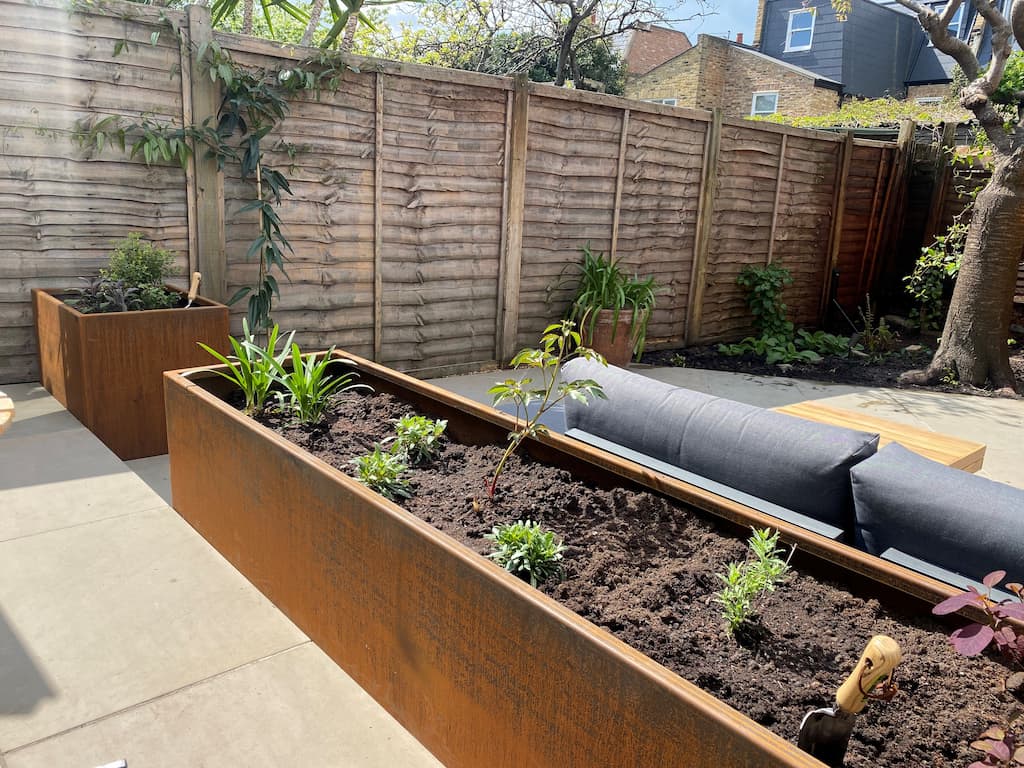Choosing the right type of planter for your outdoor space
Choosing the right type of planter for your outdoor space
There are so many types and shapes of metal pots on the market that it can be a little overwhelming trying to decide which one is right for you and your garden, patio, or balcony. In this article, we’ll take a look at some of the colours and styles on offer and discuss ideas for where each one might work best.

Contents
Round planters
Due to their shape, round metal planters tend to provide a softer feel to your garden than angular planters. They typically look less dominant in a space so there is the option to use more of them and to really show off your plants rather than draw attention to the planter as much.
Round planters can also be a more child-friendly choice as they don’t have the same number of potentially sharp edges as square planters. They are, therefore, less likely to cause injury to little ones who are playing in the garden.
Cube planters
By contrast, metal cube planters can provide a cleaner, more contemporary, feel to an outside space. A pair of cube planters on either side of an entranceway, perhaps filled with topiary, a tightly-clipped evergreen, or a standard holly, could be just the thing to provide an elegant welcome to your home.
Larger cube planters make a dramatic statement for a business entrance. They could be planted with a small tree and some low-maintenance ground cover plants like Erigeron, ivy, or creeping phlox to give potential customers a good first impression. Alternatively, ferns can look great in a shadier spot.
Trough planters
Trough planters are essentially elongated cube planters. Like cube planters, they provide an angular, crisper look to the garden than round planters. Also like cube planters, our corten steel and powder-coated trough planters can come with integrated feet to aid drainage and raise the planter up off the ground if you wish.
Metal garden troughs are ideal for putting along a fence or a wall or for adding internal screens within a garden to break it up and add height. A row of bamboo, for example, in a trough planter, or row of trough planters, could help to screen an area that you want hidden. The added advantage of using planters for bamboo is that any spreading types will be restricted and will not take over your garden.
More generally, trough planters provide you with a growing area that is suited to a wider variety of plants compared to cube planters. Whereas cube planters are great for showing off a glamorous specimen plant, trough planters are probably better for planting displays of small or medium-sized plants such as shrubs, grasses, and bedding plants.
Large planters
Large garden planters are typically lower maintenance than smaller ones. This is because they hold a far larger volume of potting soil or compost so hold on to water and nutrients longer. They will, therefore, need less frequent watering and feeding, although obviously a greater quantity of it when you do! They also hold larger, or a larger number of, plants, meaning that you have a greater range of options when it comes to creating an eye-catching display.
From a design point of view, large planters can actually work well in quite a small space as a common fault when designing a garden is to have a planter or garden ornament that is too small and can easily get lost in the space and even look a bit forlorn. A larger garden will, self-evidently, benefit from larger planters, and probably in groups or different sizes depending on the effect you want to create.
Tree planters
Metal tree planters are obviously usually among the larger planters. They also tend to be taller and may be bottomless. Bottomless planters work well when a planter is placed directly onto soil as they allow trees and other large plants to root into the ground below. This will reduce the need for watering and feeding as plants can access naturally occurring water and nutrients from the soil, as well as help to anchor plants more securely. These planters are obviously less moveable so placing them takes more forward planning as they are more of a long-term feature.
Tapered planters
A tapered planter is wider at the top than at the bottom. They may be angular shaped or cone shaped but do have the same basic principle: any deeper rooted plants will do better in the centre of the planter, whereas shallower rooted plants, such as annual bedding, salad leafy greens, or many trailing plants will do better at the edges. Trailing plants, in particular, will provide an interesting dimension in a tapered planter as they will hang vertically downwards and so hang away from the wall of the planter.
Tapered planters will also require less potting mix compared to the same diameter non-tapered planter. As compost becomes more expensive, this is perhaps an added consideration. Or just a bit of a bonus!
Bespoke planters
For a truly unique look, you may want to opt for a custom metal planter. This could be a corner planter on either side of an entranceway, or perhaps a U-shaped one to fit around a chimney breast or other vertical. There may be a triangle to fit into a corner that meets your needs or perhaps a hexagonal one to show off a beautiful ornamental tree. You may even have some round decking that you want to edge with curved planters.
Hopefully, this article has given you food for thought if you are thinking of adding a planter or several planters to your garden or outdoor space. Ready to enhance your outdoor space? Dive into our selection of planters, including the stylish corten steel, elegant galvanised steel, and colourful powder-coated options—there’s something for every garden.
